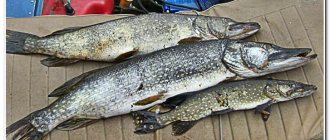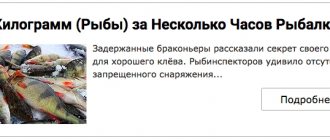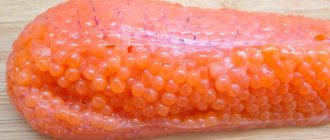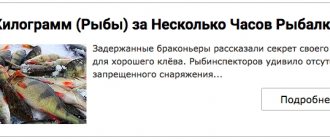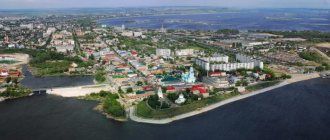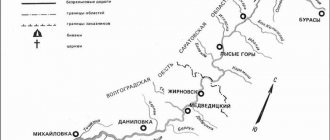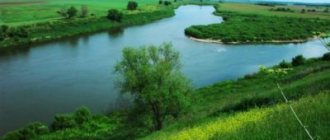Fishing in Astrakhan in autumn
The beginning of autumn is one of the best periods for fishing for pike, perch, pike perch, and asp. Before the arrival of cold weather, these types of predatory fish become active in all reservoirs of Astrakhan:
- For successful catfish fishing during this period, local experts recommend using bottom gear or jig fishing with a spinning rod.
- Catching pike with spoons, wobblers and fry will be no less productive.
- When using small-sized baits, it is possible to well replenish your catch with measured perch.
- White fish lovers will have a good time catching bream using bottom tackle.
In September and early October, you have the highest chances of catching a trophy carp, which, as the reservoirs cool, moves closer to the holes under steep ravines or cliffs. With the arrival of the first cold weather, the “golden” time of pike perch, pike and asp begins, which make up more than half of the total catch of predatory fish.
Fishing rules in the Astrakhan region for 2021
Memo for amateur fishermen fishing in the Astrakhan region
Citizens have the right to carry out recreational and sport fishing in public water bodies of the Astrakhan region freely and free of charge in compliance with the Fishing Rules for the Volga-Caspian Fishery Basin, approved by Order of the Ministry of Agriculture of the Russian Federation dated November 18, 2014 No. 453.
In accordance with the Fishery Rules for the Volga-Caspian fishery basin, recreational and sport fishing is prohibited from:
- during prohibited periods : from May 16 to June 20 - everywhere , with the exception of water bodies of fishing significance within the administrative boundaries of settlements, as well as in fishing areas provided for the organization of recreational and sport fishing during this period; from April 1 to June 30 - crayfish.
— in relation to certain types of aquatic biological resources : sturgeon species, kutum, whitefish, vimbe, barbel, burbot, badyaga. Amateur and sport hunting of the Caspian seal is prohibited.
— in forbidden areas : the Volga forbidden pre-estuary space, spawning grounds, wintering pits.
For fishing in the Astrakhan region, it is allowed to use the following tools and methods of production (catch):
float rod, consisting of a rod (including one with guide rings and a removable reel with fishing line), fishing line, float, sinkers, leashes and hooks;
bottom fishing rod (donka), consisting of a rod (including with guide rings and a removable reel with fishing line or cord) or a whip, fishing line or cord, sinker, leashes and hooks;
bottom fishing rod, consisting of a rod (including one with guide rings and a removable reel with fishing line and cord) or a whip, fishing line, sinker, feeder or bait trap with no more than 2 hooks;
bottom fishing rod with shock absorber (only single hooks are used);
spinners, wobblers, flies and other baits, different in shape and color with hooks (single, double or treble);
crayfish traps, in the amount of no more than three pieces per citizen, each of the parameters of the permitted crayfish traps (length, width, height - for polygonal ones, height, diameter - for conical and cylindrical ones) should not exceed 80 cm;
fishing (catch) on the lane using a rowing vessel or floating craft using no more than two baits per vessel or floating craft;
fishing (catch) by trolling - using a sail and/or motor using no more than two baits per vessel or floating craft;
production (catch) of fish “for kwok”;
boats;
girders;
special shotguns and pistols for underwater hunting;
spinning tackle (spinning), consisting of a rod with guide rings and a handle on which a removable reel with fishing line or cord is attached and equipped with one bait with hooks (single, double or treble). Additionally, a sinker without hooks can be placed in front of the bait.
Hooks - doubles or hooks - tees are used only when fishing with a spinning rod and a lure.
Attention! The total number of hooks used (single, double or treble) should be no more than five pieces on all fishing gear for one citizen.
IMPORTANT! All other tools and methods of production (catch) for amateur and sport fishing in the Astrakhan region are PROHIBITED!
Also, anglers should not allow catching fish smaller than the established minimum size (cm).
| Asp | 32 |
| Zander | 37 |
| Bream | 24 |
| Pike | 32 |
| Carp | 40 |
| Freshwater catfish | 60 |
| Roach, roach | 17 |
| Rudd | 17 |
| Chekhon | 22 |
| Tench | 22 |
| Cancers | 10 |
The permissible size of aquatic biological resources is determined in fresh form:
in fish - by measuring the length from the top of the snout (with the mouth closed) to the base of the middle rays of the caudal fin;
in crustaceans , by measuring the body from a line connecting the middle of the eyes to the end of the tail plates.
Extracted (caught) aquatic biological resources that are less than permissible in length must be immediately released into their natural habitat with the least possible damage.
Fans of spearfishing coming to the Astrakhan region should remember that spearfishing is prohibited :
— in prohibited and closed areas for fishing, during periods (periods) prohibited for the extraction (catch) of aquatic biological resources;
— in places of mass and organized recreation for citizens;
- using scuba gear and other self-contained breathing apparatus. It is not permitted to use special pistols and shotguns for underwater hunting from the shore, from the side of floating craft, or from wading.
The daily rate of production (catch) of aquatic biological resources (except for the case where such aquatic biological resources are subject to a permanent or temporary ban on production (catch) during recreational fishing) for each citizen during recreational fishing is indicated in the table
| Name of aquatic biological resources | Daily production (catch) rate |
| Vobla | 10 kg |
| Roach | 10 kg |
| Bream | 10 kg |
| Gustera | 10 kg |
| Carp | 10 kg |
| Zander | 10 kg |
| Bersh | 10 kg |
| Pike | 10 kg |
| Freshwater catfish | 1 copy |
| Tench | 10 kg |
| Chekhon | 10 kg |
| Blackback herring | 10 kg |
| Asp | 10 kg |
| Silver carps | 10 kg |
| white cupid | 10 kg |
| Rudd | 10 kg |
| crucian carp | 10 kg |
| Freshwater perch | 10 kg |
| Sinets | 10 kg |
| Cancers | 50 copies |
The total daily production (catch) rate for all types of aquatic biological resources (except for freshwater catfish), including those not listed in the table, is no more than 10 kg or one specimen if its weight exceeds 10 kg.
If the total daily norm is exceeded, the extraction (catch) of aquatic biological resources is stopped.
ATTENTION! Citizens guilty of violating the Fishing Rules are liable in accordance with the legislation of the Russian Federation.
When brought to administrative responsibility for violating the rules regulating fishing, citizens may be subject to a fine in the amount of two thousand to five thousand rubles with or without confiscation of the vessel and other equipment for extracting (catching) aquatic biological resources (Part 2 of Article 8.37 of the Administrative Code RF).
Illegal extraction of aquatic biological resources may result in criminal liability provided for in Article 256 of the Criminal Code of the Russian Federation, if this act is committed:
a) causing major damage;
b) using a self-propelled floating vehicle or explosives and chemicals, electric current or other prohibited weapons and methods of mass destruction of aquatic biological resources;
c) in spawning areas or on migration routes to them;
d) in specially protected natural areas or in an environmental disaster zone or in an environmental emergency zone.
For this crime, the convicted person is punishable by a fine in the amount of three hundred thousand to five hundred thousand rubles, or in the amount of the wages or other income of the convicted person for a period of two to three years, or by correctional labor for a term of up to two years, or by imprisonment for the same term.
In addition, the fisherman must remember that while fishing he is within the boundaries of water protection zones of rivers, lakes, streams, canals (50-200 m from the coastline depending on the length of the watercourse), where there is a special regime for carrying out economic and other activities for the purpose of preventing pollution, clogging, siltation of these water bodies and depletion of their waters, as well as preserving the habitat of aquatic biological resources and other objects of flora and fauna.
Within the boundaries of water protection zones, the movement and parking of vehicles (except for special vehicles) is prohibited with the exception of their movement on roads and parking on roads and in specially equipped places with hard surfaces.
Violation of this prohibition entails administrative liability in the form of a fine for citizens in the amount of three thousand to four thousand five hundred rubles (Part 1 of Article 8.42 of the Code of Administrative Offenses of the Russian Federation).
Also prohibited is the washing of vehicles within the fishery protection zones of water bodies of fishery importance in the Astrakhan region (depending on the length of the water body, the width of the zone ranges from 50 to 200 meters from the water area).
After finishing fishing, leaving the reservoir, you need to remove garbage after you.
It must be remembered that garbage left in outdoor recreation areas can cause a fire during hot, dry weather. If you find yourself in a natural fire area, you should immediately report it by calling 112.
Dear amateur fishermen!
Follow the Fishing Rules, take care of nature
and then fishing will bring you only pleasure!
You can seek clarification and advice on fishing rules and other issues of interest, as well as report cases of poaching in the water bodies of the Astrakhan region, to the Volga-Caspian Territorial Administration of the Federal Fisheries Agency by calling the hotline:
(8512) 30-21-22
website www. vktu. ru
Fishing in Astrakhan in winter
- If there is no ice on the surface of reservoirs at the beginning of winter, you can successfully fish for pike perch using jig fishing.
- With the intensification of frosts and the formation of stable ice on the surface of rivers and lakes, it is necessary to make maximum use of the potential of the girders, which allow you to catch perch, pike and pike perch.
- Using the vertical trolling method near cliffs and holes will ensure a good catch of bersh, pike and large perch.
- Float or nodding winter tackle with worm or bloodworm bait will help you replenish your trophies with silver bream, roach, rudd and saberfish.
In the presence of strong thaws, there is a possibility of catching carp or catfish, which have already managed to acclimatize after the first cold weather. With the arrival of February and the onset of the last ice, white fish become significantly more active and fish for dough, maggots, bloodworms and worms.
Autumn.
With the beginning of September it becomes cooler and the water begins to cool. Before winter, predatory fish begin to actively feed, and the bite intensifies significantly. Catfish, pike, asp, pike perch, perch - all predatory fish are perfectly caught using any bait. There is still a lot of underwater vegetation, so non-tackling and topwater lures should dominate the angler's arsenal. A great time to catch carp and all other peaceful fish. The autumn roach begins to set in October. This celebration of fishing life continues until mid-November, when the water completely cools down, the autumn feeding stops and the fish roll into the pits. In the Volga delta, fishing is prohibited in some wintering pits, and you need to listen to the rangers, who know all the forbidden pits. From mid-November until the start of freeze-up is the time for jig fishing, and at this time there is a high probability of catching trophy specimens of pike and asp.
At the end of this review, I would like to provide useful information for fishermen about the minimum sizes of fish allowed for catching in the Astrakhan region -
Fishing in Astrakhan in spring
Spring ice drift represents a start for the use of summer gear, which was idle during the winter period:
- Before the high water begins, the fish still stays at depth, so bottom tackle or jigs will be effective during this period of the year.
- In early spring, asp, pike perch, perch and pike bite most intensively. When using live bait, there is a high chance of catching catfish.
- A float rod will help fill the fish tank with roach, silver bream, bream, rudd and roach.
With the arrival of the first warmth, the fish bite well on the worm and bloodworms, which actively behave on the hook. In April, the activity of pike perch and pike increases significantly; the morning bite is stronger than the rest. No less active in May are large catfish, which are caught by jigging or trolling in the spring.
Fishing in the spring in the Astrakhan region
The Astrakhan region stretches along the Volga coast. The water space can be divided into three sections:
- Volga-Akhtuba floodplain;
- Volga delta;
- shallow Caspian zone.
Akhtuba has long attracted fans of trophy fishing. The Volga Delta is preferred by those who take their first steps in the fishing field. The Caspian areas are optimal for professionals. The peculiarities of the bottom landscape make it possible to catch catfish and carp here.
Climatic conditions make fishing in Astrakhan especially effective in spring. At the beginning of March, the Volga gets rid of ice blocks. In April comes the period of high water. At the beginning of May the river is at its fullest. Spring in the Astrakhan region is warm and quite dry. At this time, the Volga is full of fish, because the most favorable conditions have been created for habitat and spawning.
In March, fishermen begin fishing for pike, perch, ram and pike perch. The April flood allows you to get great pleasure from fishing. Everyone is hooked after the winter hunger strike. May is the period with maximum water. The Volga floods the floodplain meadows, and the fish come here to spawn. Fishermen take out spinning rods and fishing rods.
Fishing in Astrakhan in summer
Warm summer time is an excellent time for successful fishing and quality recreation in Astrakhan. In June, all reservoirs experience maximum flood levels, so fishing with a float rod and spinning rod makes sense. In the summer, every fisherman in Astrakhan has the opportunity to replenish his trophies with asp, catfish, pike perch, pike, and perch.
During the July heat, when the water warms up to 270C, there is a good bite for crucian carp, roach and buffalo. In this case, fishing will be effective only in the morning or evening. To catch catfish, it is important to use a quok, and the fishing place should be deep holes. Catching carp with a float rod or bottom tackle will be no less successful.
Spring.
Anglers, yearning for open water fishing over the winter, unsheath their spinning rods and go fishing to Astrakhan, to the Volga delta, where the best spring fishing is! From the end of March, before spawning, pike sharply become active, asp appear, and pike perch actively bite. As always, active perch are being caught. Many anglers consider the end of March - April the most interesting time for catching predators. In spring, fishing in the Volga delta is possible both in the rolling part, and in kultuks (shallow spills between adjacent channels), and in pits. When fishing in pits, jig tackle and heavy oscillating spoons or heavy castmasters are used. Fishing in the rolling part and in the kultuks is usually carried out with surface baits (wobblers, poppers, walkers, sliders), rotating and oscillating spoons. The most spectacular types of fishing are with poppers and walkers, because... Fish bites occur on the surface of the water in front of the fisherman. Interesting fishing with fly fishing gear and the increasingly popular jerkbaits. White fish are also active in the spring; silver bream, white bream, and bluegill bite like a machine gun, and by mid-April, when the water begins to warm up, carp can be caught. The underwater hunting season begins at the end of March; fishermen look for black (clear) water and hunt for pike, catfish, carp, and crucian carp. The end of April in the Astrakhan region is a holiday! The spring run of the Caspian roach begins. The river banks are dotted with fishermen carrying this famous Astrakhan trophy. Astrakhan spring roach is one of the most popular “brands” in the Astrakhan region. The end of April in Astrakhan is the beginning of the spawning ban (the ban is valid from April 20 to June 20). At this time, according to current legislation, fishing is allowed only from the shore within a populated area (1 km upstream and 1 km downstream from any populated area or tourist center). This time is most suitable for fishing peaceful fish. Fishing methods: bottom gear and feeder. As a rule, earthworms, crawlers, maggots or sweet boiled corn are used as bait. The spring flood begins in early May. In the Volga delta, water rises up to two to two and a half meters from the April level. The meadows are filled with water (a hollow is a water meadow where fish come to spawn), and Astrakhan nature comes to life. This is one of the most beautiful periods on the Volga land - lush greenery and gentle spring sunshine delights nature lovers. Separately, we can say about such a phenomenon as midges. Many fishermen are afraid to come to the Astrakhan region for fishing during the midge period. I can say that this is just a common misconception. The midge appears in the twentieth of May and completely disappears by the end of June. The midge in the Volga delta is not a natural disaster, as on the lower Volga, there are not many of them here, and it manifests itself only at sunset. During the day, especially near the water, midges are practically absent, and fishing at this time is very intense and productive. Therefore, do not be afraid of midges - come to the Volga delta and enjoy fishing, nature and the beautiful Astrakhan weather in May!
